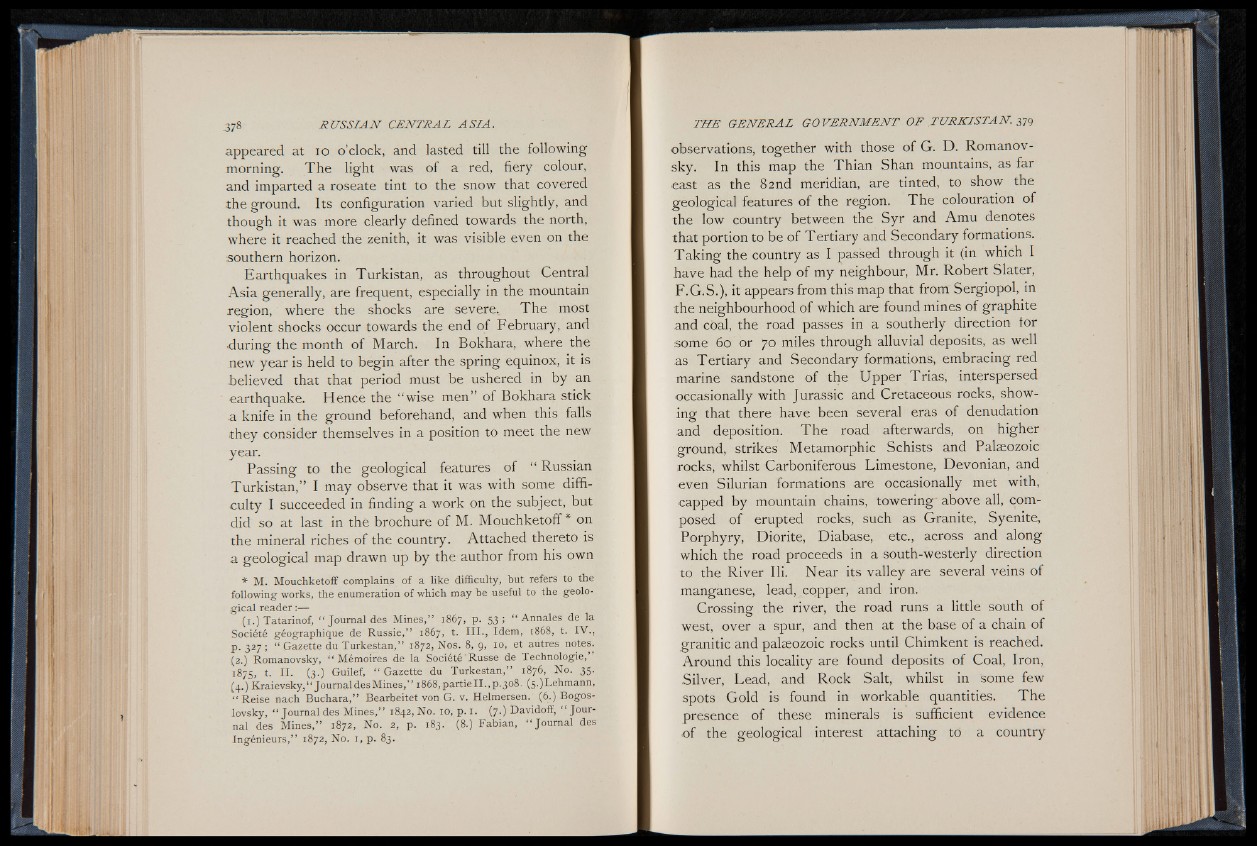
appeared at 10 o’clock, and lasted till the following
morning. The light was of a red, fiery colour,
and imparted a roseate tint to the snow that covered
the ground. Its configuration varied but slightly, and
though it was more clearly defined towards the north,
where it reached the zenith, it was visible even on the
southern horizon.
Earthquakes in Turkistan, as throughout Central
Asia generally, are frequent, especially in the mountain
region, where the shocks are severe., 1 he most
violent shocks occur towards the end of February, and
during the month of March. In Bokhara, where the
new year is held to begin after the spring equinox, it is
believed that that period must be ushered in by an
earthquake. Hence the “ wise men” of Bokhara stick
a knife in the ground beforehand, and when this falls
they consider themselves in a position to meet the new
year.
Passing to the geological features of “ Russian
Turkistan,” I may observe that it was with some difficulty
I succeeded in finding a work on the subject, but
did so at last in the brochure of M. Mouchketoff * on
the mineral riches of the country. Attached thereto is
a geological map drawn up by the author from his own
* M. Mouchketoff complains of a like difficulty, but refers to the
following works, the enumeration of which may be useful to the geolog
ic a l reader jgfesjj
( i.) Tatarinof, “ Journal des Mines,” 1867, p. 53; “ Annales de la
Société géographique de Russie,” 1867, t. I I I ., Idem, 1868, t. IV.,
p. 327 ; “ Gazette du Turkestan,” 1872, Nos. 8, 9, 10, et autres notes.
(2.) Romanovsky, “ Mémoires de la So cié té 'Russe de Technologie,”
1875, t. II . (3.) Guilef, “ Gazette du Turkestan,” 1876, No. 35.
(4.) Kraievsky,“ Journal des Mines,” i868,partieII.,p.3o8- (5.)Lehmann,
“ Reise nach Buchara,” Bearbeitet von G. v. Helmersen. (6.) Bogoslovsky,
“ Journal des Mines,” 1842, No. 10, p. 1. (y.) Davidoff, “ Journal
des Mines,” 1872, No. 2, p. 183. (8.) Fabian, “ Journal des
Ingénieurs,” 1872, No. 1, p. 83.
observations, together with those of G. D. Romanovsky.
In this map the Thian Shan mountains, as far
east as the 82nd meridian, are tinted, to show the
geological features of the region. The colouration of
the low country between the Syr and Amu denotes
that portion to be of Tertiary and Secondary formations.
Taking the country as I passed through it (in which I
have had the help of my neighbour, Mr. Robert Slater,
F.G.S.), it appears from this map that from Sergiopol, in
the neighbourhood of which are found mines of graphite
and coal, the road passes in a southerly direction for
some 60 or 70 miles through alluvial deposits, as well
as Tertiary and Secondary formations, embracing red
marine sandstone of the Upper Trias; interspersed
occasionally with Jurassic and Cretaceous rocks, showing
that there have been several eras of denudation
and deposition. The road afterwards, on higher
ground, strikes Metamorphic Schists and Palaeozoic
rocks, whilst Carboniferous Limestone, Devonian, and
even Silurian formations are occasionally met with,
capped by mountain chains, towering" above all, composed
of erupted rocks, such as Granite, Syenite,
Porphyry, Diorite, Diabase, etc., across and along
which the road proceeds in a south-westerly direction
to the River Ili. Near its valley are several veins of
manganese, lead, copper, and iron.
Crossing the river, the road runs a little south of
west, over a spur, and then at the base of a chain of
granitic and palaeozoic rocks until Chimkent is reached.
Around this locality are found deposits of Coal, Iron,
Silver, Lead, and Rock Salt, whilst in some few
spots Gold is found in workable quantities. The
presence of these minerals is sufficient evidence
o f the geological interest attaching to a country